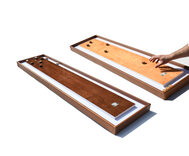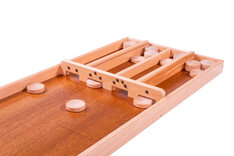The Rules of Indoor Shuffleboard and Shovelboard
The old English game of Shovelboard used to be played by the English upper classes on long tables residing in country houses. Shovelboard is no longer played but the derivative game of Sjoelbak is popular in The Netherlands, Belgium and Germany while a second descendant called Shuffleboard is popular in North America. Masters Games supplies the rules for Sjoelbak and Outdoor/Deck Shuffleboard separately. Note: 1 yard = 3 feet = 36 inches = 0.9144 metres.
Old English Shovelboard
Equipment
A Shovelboard table would be between 20 and 30 feet long, around 3 feet wide. At the target end of the Shovelboard, a line is drawn across the table, four inches from its end. Another line is drawn a further four feet away from the end. Each player has four flat metal weights, each set being uniquely marked.
Play
A coin is tossed to decide who starts. Thereafter, the winner of the previous "end" starts the next. Players slide their four weights alternately. The weight must pass over the first line and not drop off the table in order to count. It is normal for a player to deliberately knock already played weights in such a way that opponents weights might fall out of play while the player's weights cannon into an advantageous position.
Once all weights have been pushed down the table, the scores for the turn are calculated. A weight which lands on the near line or between the lines scores 1 point; a weight which lies on the far line or between the far line and the end of the board counts 2 points and a weight which hangs over the end of the table counts 3 points. If no weights are in scoring positions then the weight nearest to the near line scores 1 point.
For a two player game, the player who scores 11 points first wins. The target score would sometimes be greater when there were more than two players.
Indoor Shuffleboard
Equipment
A Shuffleboard can be any distance from 12 - 22 feet long but is generally an even number of feet in length. The height of the table from the ground should be about 30 inches and the width 20 inches. The surface is polished wood and 6 feet from the end a line is drawn across the width of the table called the foul line. Two more lines are drawn across the table nearer the end at 12 inches and 6 inches called the 2 point and 3 point lines respectively. Each player slides 4 uniquely marked, weighted metal disks down the table called weights.
Play
Players toss a coin to decide who plays first - it is advantageous to play second. After the first "end", the winner of the previous end plays first. Should the previous end have resulted in no score, the player who went first previously goes second. Players slide their four weights alternately attempting to get them as near as possible to the end of the board without falling off. If a weight does not completely pass over the foul line, that weight is immediately removed from play. It is normal for a player to deliberately knock already played weights in such a way that opponents weights might fall out of play while the player's weights cannon into an advantageous position. Once all weights have been pushed down the table, the player whose weight is nearest the far end of the board wins that "end" and scores points. The other player scores no points. In order to score, a weight must:
- be on the table
- have fully crossed over the foul line
- be nearer to the end than the opponents best weight
These rules are provided by Masters Traditional Games, an Internet shop selling quality traditional games, pub games and unusual games. For general information or for copying and copyright, see our Rules Information page.
Our rules are comprehensive instructions for friendly play. If in doubt, always abide by locally-played or house rules.
Copyright James Masters, 2025. All rights reserved.



























